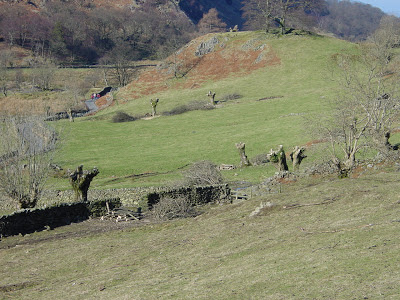Having witnessed the demise of the English Elm through the 1970’s as tree after tree succumbed to Dutch elm disease I guess it was just a matter of time until we repeated the scenario with another invasive species, after all we spend millions of euros each year moving untold quantities of plant and animal species around Europe and Asia so it should not really come as a surprise. The Lake District with its network of small farms and field systems is more or less dominated by Ash (Fraxinus excelsior) and nearly all of the mature trees in the farmed landscape are also ash! Furthermore many of the ashes are ancient pollards with a history of management going back hundreds of years and these very special trees support a wonderful array of wildlife including rare mosses and lichens and an unknown number of insect species.
 |
| Removing and burning ash at Watendlath |
 |
| Volunteers kindly gave up their time to help us |
The ash pollards form part of ancient wood pastures and in February of 2012 we planted over 600 new ash trees at Watendlath, this small idyllic hamlet is home to several hundred ancient ash trees many over 400 years old. The news of this new disease, Ash Dieback (Chalara Fraxinea) caused concern and having a contact at FERA (Food & Environment Research Agency) I was able to have these newly planted trees tested earlier this month and a few days later received the bad news that they were indeed infected. Following advice from FERA and The Forestry Commission, we took steps to try to save the woodland. The trees had been planted in tubes and fallen leaves were nicely contained within them, one week later and all had been removed and burnt on site to try to save the woodland.
 |
| Ancient pollards in Watendlath |
Was this successful? Only time will tell and next summer will reveal the true extent of the disease. The area will be closely monitored for any signs of infection by this nasty little Ascomycete and every effort made to reduce its impact on this incredibly ancient landscape that we put so much effort into conserving.

No comments:
Post a Comment